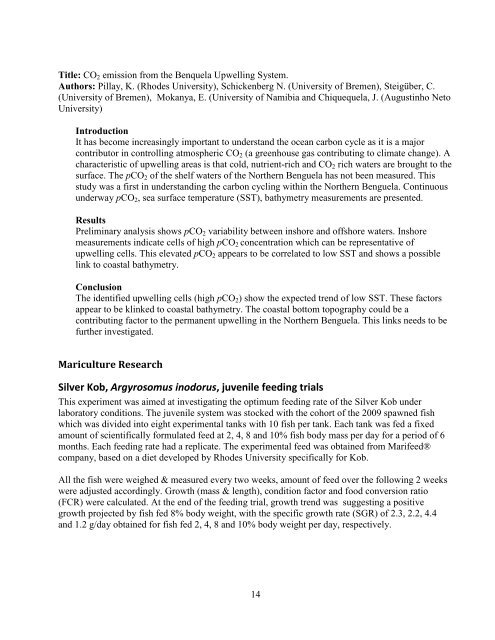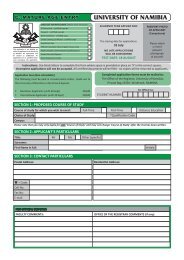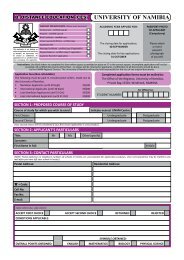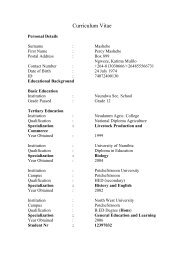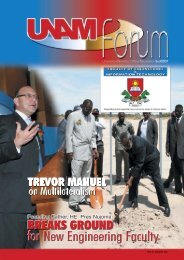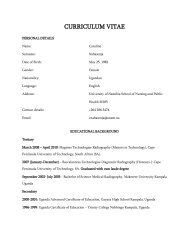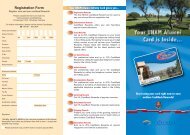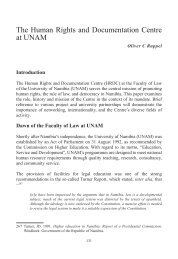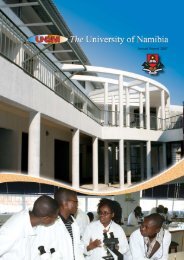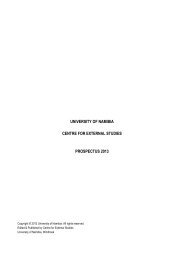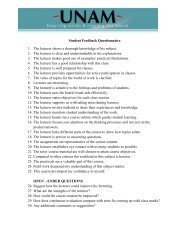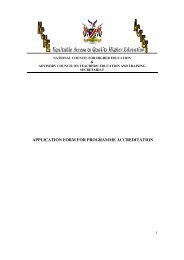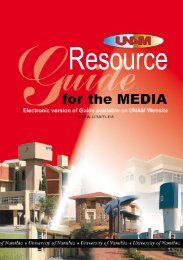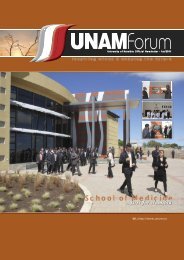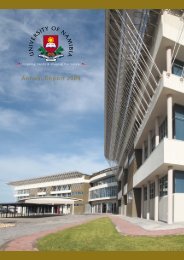ANNUAL REPORT 2011 - University of Namibia
ANNUAL REPORT 2011 - University of Namibia
ANNUAL REPORT 2011 - University of Namibia
You also want an ePaper? Increase the reach of your titles
YUMPU automatically turns print PDFs into web optimized ePapers that Google loves.
Title: CO 2 emission from the Benquela Upwelling System.<br />
Authors: Pillay, K. (Rhodes <strong>University</strong>), Schickenberg N. (<strong>University</strong> <strong>of</strong> Bremen), Steigüber, C.<br />
(<strong>University</strong> <strong>of</strong> Bremen), Mokanya, E. (<strong>University</strong> <strong>of</strong> <strong>Namibia</strong> and Chiquequela, J. (Augustinho Neto<br />
<strong>University</strong>)<br />
Introduction<br />
It has become increasingly important to understand the ocean carbon cycle as it is a major<br />
contributor in controlling atmospheric CO 2 (a greenhouse gas contributing to climate change). A<br />
characteristic <strong>of</strong> upwelling areas is that cold, nutrient-rich and CO 2 rich waters are brought to the<br />
surface. The pCO 2 <strong>of</strong> the shelf waters <strong>of</strong> the Northern Benguela has not been measured. This<br />
study was a first in understanding the carbon cycling within the Northern Benguela. Continuous<br />
underway pCO 2 , sea surface temperature (SST), bathymetry measurements are presented.<br />
Results<br />
Preliminary analysis shows pCO 2 variability between inshore and <strong>of</strong>fshore waters. Inshore<br />
measurements indicate cells <strong>of</strong> high pCO 2 concentration which can be representative <strong>of</strong><br />
upwelling cells. This elevated pCO 2 appears to be correlated to low SST and shows a possible<br />
link to coastal bathymetry.<br />
Conclusion<br />
The identified upwelling cells (high pCO 2 ) show the expected trend <strong>of</strong> low SST. These factors<br />
appear to be klinked to coastal bathymetry. The coastal bottom topography could be a<br />
contributing factor to the permanent upwelling in the Northern Benguela. This links needs to be<br />
further investigated.<br />
Mariculture Research<br />
Silver Kob, Argyrosomus inodorus, juvenile feeding trials<br />
This experiment was aimed at investigating the optimum feeding rate <strong>of</strong> the Silver Kob under<br />
laboratory conditions. The juvenile system was stocked with the cohort <strong>of</strong> the 2009 spawned fish<br />
which was divided into eight experimental tanks with 10 fish per tank. Each tank was fed a fixed<br />
amount <strong>of</strong> scientifically formulated feed at 2, 4, 8 and 10% fish body mass per day for a period <strong>of</strong> 6<br />
months. Each feeding rate had a replicate. The experimental feed was obtained from Marifeed®<br />
company, based on a diet developed by Rhodes <strong>University</strong> specifically for Kob.<br />
All the fish were weighed & measured every two weeks, amount <strong>of</strong> feed over the following 2 weeks<br />
were adjusted accordingly. Growth (mass & length), condition factor and food conversion ratio<br />
(FCR) were calculated. At the end <strong>of</strong> the feeding trial, growth trend was suggesting a positive<br />
growth projected by fish fed 8% body weight, with the specific growth rate (SGR) <strong>of</strong> 2.3, 2.2, 4.4<br />
and 1.2 g/day obtained for fish fed 2, 4, 8 and 10% body weight per day, respectively.<br />
14


